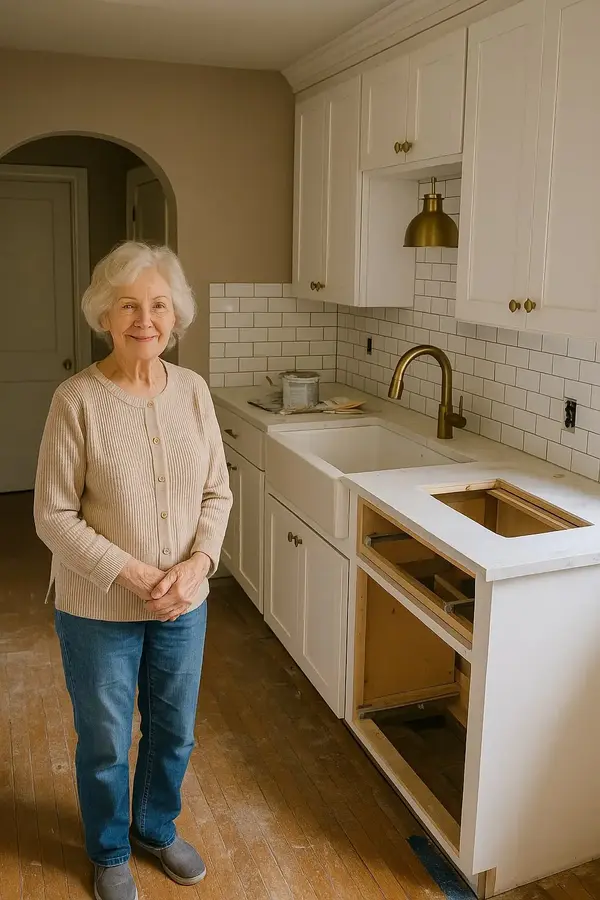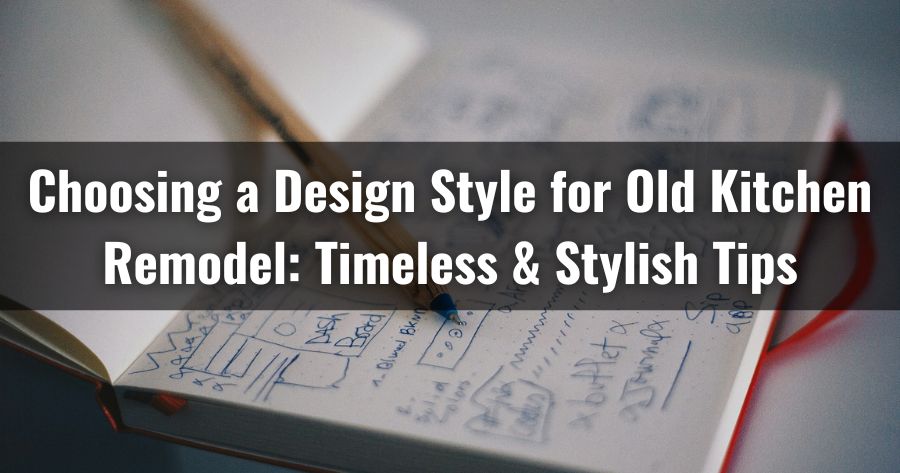The first time I walked into our 1970s kitchen, it felt like stepping into a time capsule knotty pine cabinets, orange tile countertops, and a faded linoleum floor that had seen better days. It was functional, sure, but hardly inspiring. I knew we needed a change.
But here’s the thing: remodeling an old kitchen isn’t just about ripping everything out and going “modern.” It’s about finding the right balance, honoring what makes your kitchen unique while bringing in a design style that fits your life today.
If you’re choosing a design style for an old kitchen remodel, you might be feeling stuck. Maybe you’re torn between preserving charm and embracing new trends. Maybe you’re overwhelmed with options from modern farmhouse to all-white minimalist. Or maybe you’re just not sure what will work best in your home.
You’re not alone, in this guide, we’re diving deep into how to choose a style that works for your old kitchen without erasing its character.
Why Design Style Matters for an Old Kitchen Remodel
Design isn’t just about looks. It shapes how you move, cook, gather, and feel in your space. And when you’re working with an older kitchen, there’s an added layer of complexity — existing layouts, aging materials, outdated fixtures, and historical details all come into play.
I’ve seen many people rush into full renovations, only to regret stripping out original wood floors or plaster moldings that gave their kitchen soul. A successful remodel doesn’t fight the bones of your space — it works with them.
Start with the Story: What’s Your Kitchen Telling You?
Before choosing a design style, take a good look at your current kitchen. Not just the flaws — the features too.
Ask yourself:
- What era was the kitchen originally built?
- Are there original cabinets, moldings, tile, or woodwork?
- Is there a layout element that’s quirky but kind of charming?
- How does the kitchen connect with the rest of the home?
Maybe your old kitchen has Victorian moldings, a 1950s retro tile backsplash, or hardwood floors hiding under vinyl. These aren’t problems — they’re opportunities. When you know your kitchen’s roots, you can find a design style that feels authentic.
Match the Style to Your Home — Not Just the Trend
Let’s say your home leans traditional with crown moldings, wainscoting, and natural wood details. Dropping a super sleek, glossy modern kitchen into that space might feel jarring. That doesn’t mean you can’t modernize — but you’ll need to bridge the styles intentionally.
Here are some examples of cohesive pairings:
| Home Style | Ideal Kitchen Design Styles |
|---|---|
| Victorian or Colonial | Traditional, Timeless, English Cottage |
| Mid-century Ranch | Retro-Inspired, Scandinavian Modern |
| Farmhouse or Craftsman | Modern Farmhouse, Rustic, Transitional |
| Contemporary Townhome | Minimalist, Japandi, Industrial Chic |
Pro Tip: Pull design elements (like hardware, color palette, and cabinet profile) from your home’s overall style into the kitchen for flow.
Find Your Function First, Style Second
I know it’s tempting to jump straight into Pinterest and mood boards, but start with how you use your kitchen:
- Do you cook every day or just on weekends?
- Do you entertain often?
- Is storage a pain point?
- Is lighting poor in certain areas?
Your lifestyle should lead the layout and design. A timeless style won’t matter if your kitchen doesn’t function well. And often, old kitchens weren’t built for modern appliances or open family living.
Some ideas that blend form and function beautifully:
- Replacing upper cabinets with open shelving for airiness (especially in small kitchens).
- Using natural wood cabinets or painted cabinets with inset doors for a classic but functional upgrade.
- Incorporating a kitchen island if space allows — or a rolling butcher block if not.
Choose a Design Style That Can Grow with You
Trends come and go, but the kitchen is an investment. Lean toward timeless kitchen design elements that feel fresh today and still hold up a decade later.
Timeless Elements to Consider:
- Shaker-style cabinets – Simple, clean, and adaptable to many styles.
- White or neutral cabinetry – Easily updated with new hardware or wall color.
- Subway tile backsplash – Affordable, classic, and pairs with most countertop styles.
- Natural wood or quartz countertops – Durable and never go out of style.
- Pendant lighting over islands or sinks – Adds personality without overwhelming the space.
You can still add personality with:
- A statement range hood
- A bold tile floor
- Brass hardware or a colorful kitchen sink
These are easier to swap out down the line if tastes change.
Bridging Old and New: Top 3 Style Approaches That Work
1. Modern Farmhouse
A cozy blend of rustic and modern. Works well in older homes with character.
Key Features:
- Natural wood cabinets or open shelving
- Apron-front sink
- Matte black or brass hardware
- Light, warm color palettes
Perfect if you want a kitchen that feels both fresh and homey.
2. Transitional Style
The sweet spot between traditional and contemporary.
Key Features:
- Shaker or flat-panel cabinetry
- Neutral colors (gray, beige, off-white)
- Clean lines with subtle decorative touches
- Mix of natural and man-made materials (like quartz with wood floors)
This style is great if you want flexibility to evolve over time.
3. Classic Traditional with Modern Touches
Keep the soul of your old kitchen, but give it a facelift.
Key Features:
- Crown molding and cabinetry details
- Natural stone countertops (like granite or marble)
- Warm lighting with vintage-style pendant fixtures
- Rich wood floors or tile that mimics it
Add modern elements like a sleek backsplash or integrated appliances to avoid feeling dated.
Watch for Common Pitfalls When Remodeling an Old Kitchen
Remodeling comes with landmines — here are a few traps I’ve seen clients walk into:
- Over-modernizing: Don’t erase all the charm. Blend old and new thoughtfully.
- Ignoring structure: Older kitchens often have quirks (low ceilings, narrow doors) — work with them, not against them.
- Underestimating lighting: Many old kitchens are dim. Plan task lighting, under-cabinet lighting, and ambient pendant lights.
- Choosing trendy over timeless: That forest green cabinet trend may not age well. Go timeless on big-ticket items, trendy on accessories.
For more visual inspiration, I always recommend checking sites like Houzz to see real remodels that reflect various design styles in old kitchens.
Real-Life Example: Breathing New Life Into a 1940s Kitchen

One of my favorite transformations was a 1940s galley kitchen with original tile countertops and a built-in ironing board.
The owner wanted a modern feel but loved the quirky tile and arched doorway. We:
- Kept the arch and restored it
- Replaced the tile countertop with white quartz
- Painted the original cabinets a warm greige
- Swapped outdated lighting for matte brass pendants
- Refinished the hardwood floor beneath old linoleum
The result? A kitchen that felt brand new but still told its story.
Conclusion: Your Old Kitchen Deserves a Design Style That Respects Its Roots
Choosing a design style for an old kitchen remodel isn’t about trends — it’s about translating your space’s history into a fresh, functional reality. When you blend what’s timeless with what feels like you, you don’t just get a kitchen — you get a room that feels like home.
Key Takeaways:
- Start by understanding your kitchen’s existing character.
- Choose a style that complements your home’s overall architecture.
- Prioritize function and timeless design elements.
- Consider transitional, modern farmhouse, or classic styles for balance.
- Avoid over-modernizing and plan lighting early.
Remember: You’re not erasing history — you’re writing the next chapter.
If you found this helpful, subscribe to our newsletter for more practical tips, style inspiration, and real-world kitchen makeovers. You can also follow us on social media for daily insights and behind-the-scenes peeks at our latest projects.
And hey — check out our related articles on budget-friendly cabinet upgrades and maximizing space in small kitchens to take your remodel to the next level.
FAQ’s
How can I keep my remodeled kitchen looking fresh without a full renovation?
Even without a complete kitchen renovation, small updates can make a big difference. Try swapping out hardware and fixtures like handles and faucets for a modern touch. A new backsplash or freshly painting the cabinets can refresh the space instantly. This is especially useful if you want to modernize a traditional kitchen without the cost of starting from scratch.
What’s the best way to create a functional layout in a small kitchen?
In a small kitchen, functionality comes first. Focus on an efficient kitchen layout—like a galley or L-shape—and use compact, multi-purpose kitchen appliances. Open shelving or narrow cabinetry can make the space feel more open, and smart lighting like under-cabinet LEDs can help maximize your work areas.
Can I combine modern and traditional styles in my old kitchen remodel?
Absolutely. A successful kitchen doesn’t have to choose sides. A blend of modern and traditional kitchen design can feel timeless and personal. Think natural wood floors paired with a sleek range hood, or white kitchen cabinets with brushed brass pulls. The key is a consistent overall design that flows with the style of your home.
How do I avoid common mistakes when choosing a kitchen design style?
One of the biggest mistakes is ignoring the style of your home. A modern kitchen might clash with a farmhouse interior. Also, avoid trendy finishes that could date quickly. Instead, explore lasting kitchen ideas and use a solid renovation guide to align your choices with long-term value and function.
What’s a smart way to save money on a full kitchen remodel?
To build an affordable kitchen, reuse elements where possible—like painting the cabinets instead of replacing them. Opt for budget-friendly tile instead of custom stonework, and explore DIY-friendly updates. Keeping your existing kitchen layout also helps cut down on plumbing and electrical changes, which can quickly inflate your budget.
What’s the best way to make a white kitchen feel warm and not sterile?
To keep an all-white kitchen from feeling too cold, layer in texture and warmth. Think hardwood floors, matte tile, or natural wood open shelves. Warm lighting, like soft white pendant fixtures, adds coziness. Accent decor in muted tones can also prevent the space from feeling overly clinical.
Are there safety considerations I should keep in mind when renovating the kitchen?
Yes, especially when replacing kitchen appliances or moving plumbing. Make sure all installations meet code—especially for gas ranges and electrical outlets near the sink. Use slip-resistant floor materials, especially in high-traffic areas, and ensure lighting is well-placed. A safer kitchen is a smarter, more successful kitchen.
What are some quick decor ideas to personalize my remodeled kitchen?
Once the remodel is done, it’s time to bring in personality. Add some decor ideas like vintage wall art, glass canisters, or a plant on your countertop. Swapping out rugs and barstools seasonally can keep your kitchen space feeling fresh. These touches bring your dream kitchen to life without major effort or expense.





